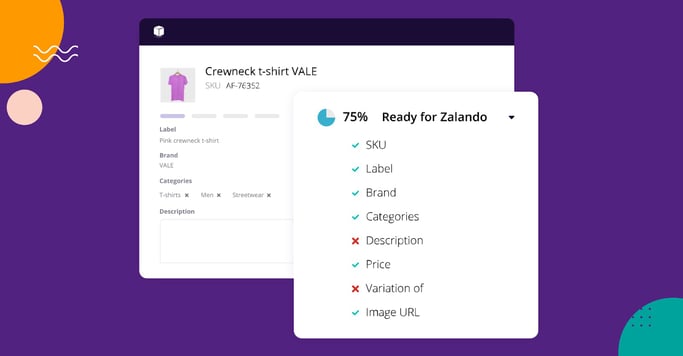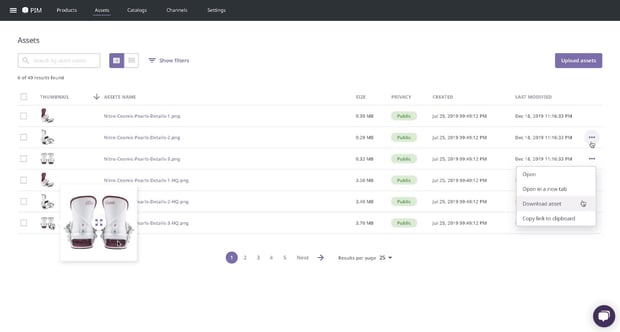How Bad Product Information Is Sabotaging Your Multichannel Success

Keep the good stuff coming
Subscribe to our blog newsletter and get monthly content that helps you manage product data smarter.
No spam. Just real value.
Customer relationships are what fuel success in retail.
Whether online or in brick and mortar stores, these relationships are what make or break retailers. That being said, there are a number of ingredients that create the perfect recipe for customer relationship success, but the biggest of them all is customer experience. In fact, if customers have a poor customer experience, 58% of customers are likely to stop doing business with that company.
So, is this groundbreaking news for you as a retailer? Is this the first time you’ve heard of the importance that customer experience holds in retail? No, probably not. But, customer experience is so much more than a well-packaged product and a smiling customer service agent, especially in ecommerce. Sometimes there are factors that are out of your control and still lead to poor customer experience.
Where did my customers go?
As a multichannel commerce retailer, you're familiar with many challenges. And one of those is product data management. From product data input and data transfers between channels to importing product images and media, product content management can be a nightmare. This nightmare of a task becomes even worse when it begins to affect site navigation and user experience.
Imagine a customer orders a new laptop from your Google Store. They are excited to get their new package, and when they break open the package, their beaming smile... drops. The laptop is not the one they ordered. But, how did this happen?
When plugging product information into your spreadsheet, you accidentally duplicated the description, and the customer bought a laptop based on the wrong description. What was a simple error on your part now seems like a potential scam. The customer now feels duped and doesn’t trust your business anymore.
Situations like these make over 80% of companies lose confidence in their product data. This is scary because, as a business, you feel uncertain—you never know when there will be an issue with your data. But luckily, there are many ways that bad data can be created, and there are solutions. To tackle the ecommerce challenge of bad data, you need to look at how they can happen and their impact.
What does bad data look like?
Bad data can come in many forms and happen in the blink of an eye. Often, they are unintentional mistakes that happen when transferring product data.
Here are the types of data mistakes to stay on the lookout for:
- Incomplete data: an empty field where there is product information necessary
- Inaccurate data: content that hasn’t been properly entered or updated
- Inappropriate data: information that was placed in the wrong field
- Non-conforming data: information that doesn’t match the attribute type specifications (using symbols or characters that don’t belong to that attribute)
- Duplicate data: a product or SKU that is placed more than once in a list
- Poor data entry: any general mistakes and incorrectly transferred data found in naming, spelling, and format

The consequences of bad data
If bad data isn’t fixed in time, often there are consequences to pay.
Nearly 60% of organizations don’t measure the annual financial cost of poor quality data, according to the Gartner survey. This is exactly how companies find themselves at a $15 million average annual financial cost of poor data quality.
Your wallet shouldn’t be your only concern with bad data, you can find yourself with numerous other issues that include:
- Increased churn rate
- Real-time errors
- Multichannel commerce information inconsistencies
- Delivery errors
- Higher consumption of resources
- Negative reviews and comments on social media
- Inaccurate metrics
- Less productivity
- Higher spam counts and unsubscribers
- Loss of upselling opportunities
- Frustration within sales and marketing departments
- Loss of revenue
The list goes on, but you get the point.
Bad data creates bad business and a lot more problems for you to solve.
The bad data antidote
Don’t get down about the potential issues and the uncertainty of when the next bad data incident is lurking around the corner. Fortunately, there are ways to help manage and eliminate these poor data issues. If you are currently faced with unhappy customers who have suffered from the results of your bad data, own up to it and explain that you are taking action to guarantee a better experience.
This honest and transparent approach can help heal any wounds that resulted from the negative customer experience. But, you need a plan and support to make sure that your customers don’t deal with repeat bad data offenses. You should take a look into how you can treat your data to go from poor to high-quality.
Fixing your product information isn’t an easy feat, considering that 75% of companies said they had difficulties agreeing on standardization for their data, let alone fixing the actual data itself. Finding a product data management system that helps you do this is the next step in achieving high-quality data.
Data tools are a sure and fast way to help you stay on top of your product data quality. Using third-party product information management (PIM) software helps take the pressure off of businesses, and the time saved in managing data can be better used to expand multichannel and omnichannel commerce.
There are three common tools you can use for product data:
All of these tools can be helpful in your information management practices and are worth considering when restructuring your data management.

Use Plytix PIM to save you from bad data
Our affordable PIM helps you avoid bad data so that you can reach multichannel success. It is a central source for all of your information. Once you have put in your data, you can distribute it to multiple ecommerce channels with confidence.
Plytix PIM helps set you up for success with quality data that is:
- Complete: Plytix PIM is able to track the completeness level of your product information. This will help you monitor your product's status
- Conforming: fitting attributes can be set up to help choose the right attribute type for the content, for example, decimal for measurements
- Correct: systems are set up to help keep products in the right format, giving you a heads up when a duplicate product is detected
Don’t miss out on another dime due to incorrect, poor product content. Set your ecommerce web store up for long-term success, so that when your customer buys a laptop from you, they’ll continue smiling even once the package is opened.
Interested in seeing how to make your product information quality data?
Give Plytix PIM a spin for free, no credit card needed.

Bergen Palmer
Bergen Palmer is a content marketer at Plytix, where she writes all about product information and ecommerce. With a background in ecommerce SaaS and content strategy, she focuses on creating clear, trustworthy content that helps brands work better with their product data.

What if your product data actually worked for you?
We’ll show you how Plytix helps you stop fixing data—and start using it.
Related posts
Keep the good stuff coming
Subscribe to our blog newsletter and get monthly content that helps you manage product data smarter.
No spam. Just real value.





Think others should see this?
Go ahead and share it.